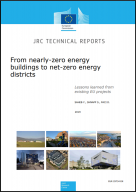Details
- Publication date
- 1 January 2019
- Author
- Joint Research Centre
Description
The implementation of the EU 2020 energy and climate targets triggered the transformation of Europe’s neighbourhoods to net-zero energy districts (NZED). The Report review and analyses the cases of frontrunner municipalities In Europe. They set ambitious targets to reduce their energy demand and to increase the share of their energy supply from local renewable energy sources.
These targets are set in different ways and the timeline to meet the agreed target at a local level varies from one municipality to another. Hvar, a remote Croatian Island, as well as the municipality of Val-de-Ruz, in Switzerland, have set a target to be self-sufficient. However, the former aims at meeting its self-sufficiency target to be 20% by 2020 while the latter aims to be totally self-sufficient by 2030. Similarly, the municipality of Helsingor in Denmark aims for carbon neutrality by 2050 while Cloughjordan in Ireland aimed at building an eco-village in a rural area. Other municipalities such as Salzburg in Austria developed a 2050 smart city roadmap while Valby in Denmark set a renewable energy target and the municipality of Zaragoza in Spain developed and implemented a holistic bioclimatic design at neighbourhood level.
Other important features of the seven districts analysed in this report are the emergence of new actors and the innovative governance structures set by municipalities to ensure all necessary actors are involved, and the use of modern technologies (such as smart meters, smart communication tools, social media platform, 3D-Scanning and Building Information Models – BIM). In all the cases analysed, public finance (EU and national) has been instrumental in unleashing the transition to net-zero energy districts.

